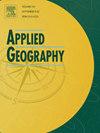Can innovation-driven productivity mitigate infrastructure spatial inequality? Evidence from 282 prefecture-level cities in China
IF 5.4
2区 地球科学
Q1 GEOGRAPHY
引用次数: 0
Abstract
Spatial inequality in infrastructure remains prominent under China's urban-rural dualism and regional imbalances during high-quality development. This study investigates whether innovation-driven productivity (IDP) - a core socioeconomic driver for shared prosperity - can mitigate infrastructure disparities. Employing TOPSIS modeling, inequality indices, and two-way fixed-effects analyses across 282 Chinese prefecture-level cities, we reveal: (1) National IDP levels show sustained growth, with eastern regions maintaining leadership in both magnitude and growth pace. (2) Infrastructure spatial inequality (ISI) follows an initial increase then decline, featuring pronounced early-stage regional disparities characterized by a “high in the north, low in the south” spatial pattern. (3) IDP development exhibits a significant inverted U-shaped relationship with ISI, initially exacerbating then alleviating disparities. (4) Heterogeneity analysis identifies distinct impact mechanisms across developmental stages and geographic regions. By demonstrating how IDP's effects vary spatiotemporally, this research provides practical guidance for optimizing land and space resource allocation, enhancing spatial fairness and justice, and promoting regional coordinated development. The findings inform targeted policy strategies that harness innovation dynamics to reduce urban-rural divides, support phased infrastructure investments, and ultimately advance shared prosperity through spatially adaptive governance approaches.
创新驱动的生产力能否缓解基础设施空间不平等?来自中国282个地级市的证据
在中国城乡二元体制和高质量发展的区域不平衡背景下,基础设施空间不平等依然突出。本研究探讨了创新驱动生产率(IDP)——共享繁荣的核心社会经济驱动力——能否缓解基础设施差距。通过对282个地级市的TOPSIS模型、不平等指数和双向固定效应分析,我们发现:(1)全国国内生产总值水平持续增长,东部地区在规模和速度上都保持领先地位。②基础设施空间不平等呈现先上升后下降的趋势,早期区域差异明显,呈现“北高南低”的空间格局。(3)国内流离失所人口的发展与ISI呈显著的倒u型关系,先加剧后缓解。(4)异质性分析表明,不同发展阶段和地理区域的影响机制存在差异。通过揭示国内流离失所效应的时空变化规律,为优化国土空间资源配置、增强空间公平正义、促进区域协调发展提供实践指导。研究结果为有针对性的政策战略提供了信息,这些战略可以利用创新动态来缩小城乡差距,支持分阶段的基础设施投资,并最终通过空间适应性治理方法促进共享繁荣。
本文章由计算机程序翻译,如有差异,请以英文原文为准。
求助全文
约1分钟内获得全文
求助全文
来源期刊

Applied Geography
GEOGRAPHY-
CiteScore
8.00
自引率
2.00%
发文量
134
期刊介绍:
Applied Geography is a journal devoted to the publication of research which utilizes geographic approaches (human, physical, nature-society and GIScience) to resolve human problems that have a spatial dimension. These problems may be related to the assessment, management and allocation of the world physical and/or human resources. The underlying rationale of the journal is that only through a clear understanding of the relevant societal, physical, and coupled natural-humans systems can we resolve such problems. Papers are invited on any theme involving the application of geographical theory and methodology in the resolution of human problems.
 求助内容:
求助内容: 应助结果提醒方式:
应助结果提醒方式:


